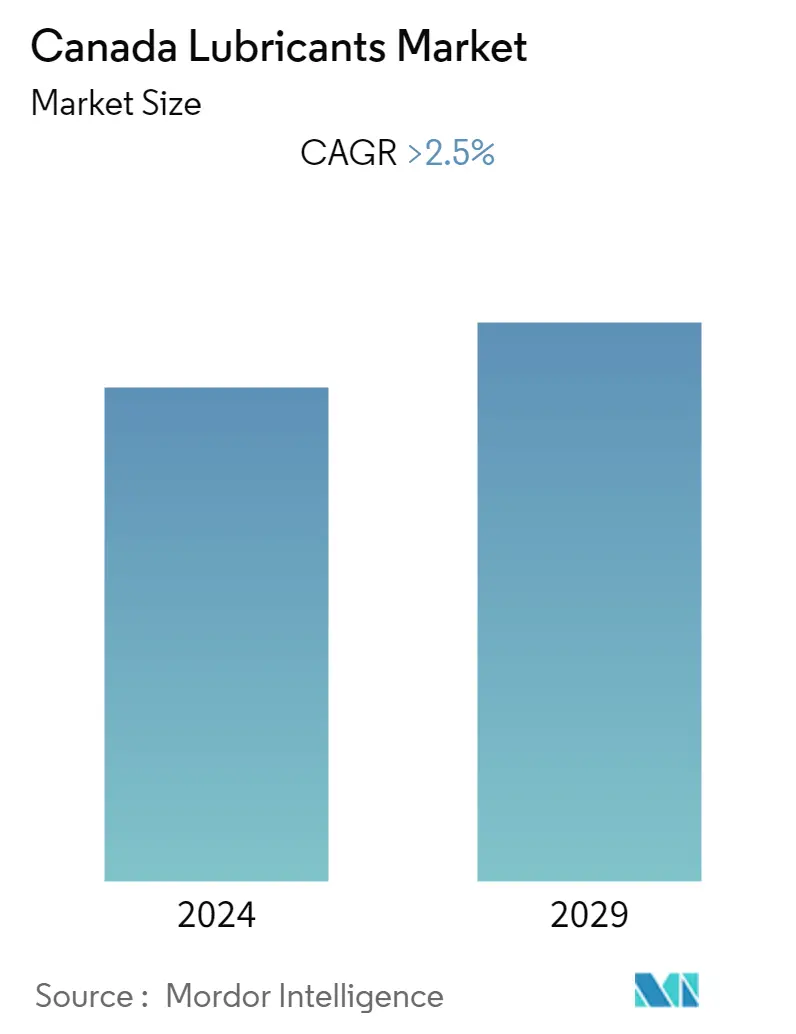Market Size of Canada Lubricants Industry

| Study Period | 2019 - 2029 |
| Base Year For Estimation | 2023 |
| Forecast Data Period | 2024 - 2029 |
| Historical Data Period | 2019 - 2022 |
| CAGR | 2.50 % |
| Market Concentration | High |
Major Players
*Disclaimer: Major Players sorted in no particular order |
Canada Lubricants Market Analysis
The Canada lubricants market is projected to register a CAGR of over 2.5% during the forecast period.
The COVID-19 outbreak in 2020 and the first half of 2021 significantly affected the industrial and automotive sectors, caused major production disruptions, and negatively affected customers' purchasing power in Canada, limiting the growth of the Canadian lubricants market. However, the sector is recovering well since these restrictions were lifted. In 2021, annual automotive sales in the country reached 1.70 million units, registering a y-o-y increase of 7%.
- Over the medium term, major factor like the growing sales of motor vehicles in the country is expected to drive the demand for lubricants.
- Conversely, lubricating oil risks will likely hinder the market's growth.
- The growing demand for biodegradable lubricants may create lucrative opportunities for market growth.
- The automotive segment dominated the market in the country and is also likely to witness the highest CAGR during the forecast period.
Canada Lubricants Industry Segmentation
A lubricant is any physically integrated substance to lessen friction between two or more moving surfaces. Lubricants help to stop material deterioration, erosion, corrosion, and rust formation on metallic surfaces. 90% petroleum-based oil is normally the base of lubricants, and various additives are added to provide useful qualities specific to a given user. The Canadian lubricants market is segmented by product type and end-user industry. By product type, the market is segmented into engine oils, greases, hydraulic fluids, metalworking fluids, transmission and gear oils, and other product types. By end-user industry, the market is segmented into automotive, heavy equipment, metallurgy and metalworking, power generation, and other end-user industries. The market sizing and forecasts have been done for each segment based on volume (million liters).
| Product Type | |
| Engine Oil | |
| Greases | |
| Hydraulic Fluids | |
| Transmission & Gear Oil | |
| Metalworking Fluids | |
| Other Product Types |
| End-user Industry | |
| Automotive | |
| Heavy Equipment | |
| Metallurgy and Metalworking | |
| Power Generation | |
| Other End-user Industries |
Canada Lubricants Market Size Summary
The Canadian lubricants market is experiencing a recovery following the disruptions caused by the COVID-19 pandemic, which had a significant impact on the industrial and automotive sectors. The market is projected to grow steadily over the forecast period, driven primarily by the increasing sales of motor vehicles. The automotive segment remains the dominant force in the market, with engine oil being the leading product type due to its essential role in high-temperature and high-pressure applications. The demand for engine oil is particularly supported by the servicing needs of on-road passenger and commercial vehicles, including the widespread use of class 7 and class 8 trucks. Despite challenges such as the risks associated with lubricating oils, the market is poised for growth, with opportunities emerging from the rising demand for biodegradable lubricants.
Canada's automotive industry, being the second-largest in North America, plays a crucial role in the lubricants market. The presence of major international automakers and the stability of the automobile aftermarket contribute to the market's dynamics. The increasing number of registered road motor vehicles, both gasoline and diesel, further fuels the demand for engine oil and other lubricants. The market is partially consolidated, with key players like BP PLC (Castrol), Exxon Mobil Corporation, and Shell Plc leading the charge. Recent strategic moves, such as TotalEnergies Marketing Canada's launch of a digital platform for lubricant selection and Saudi Aramco's acquisition of Valvoline's global product division, highlight the ongoing developments and competitive landscape within the market.
Canada Lubricants Market Size - Table of Contents
-
1. MARKET DYNAMICS
-
1.1 Drivers
-
1.1.1 Growing Sales of Motor Vehicles
-
1.1.2 Increasing Demand from Manufacturing Industry
-
-
1.2 Restraints
-
1.2.1 Risks Associated with Lubricating Oils
-
1.2.2 Other Restraints
-
-
1.3 Industry Value Chain Analysis
-
1.4 Porter's Five Forces Analysis
-
1.4.1 Bargaining Power of Suppliers
-
1.4.2 Bargaining Power of Consumers
-
1.4.3 Threat of New Entrants
-
1.4.4 Threat of Substitute Products
-
1.4.5 Degree of Competition
-
-
-
2. MARKET SEGMENTATION (Market Size by Volume)
-
2.1 Product Type
-
2.1.1 Engine Oil
-
2.1.2 Greases
-
2.1.3 Hydraulic Fluids
-
2.1.4 Transmission & Gear Oil
-
2.1.5 Metalworking Fluids
-
2.1.6 Other Product Types
-
-
2.2 End-user Industry
-
2.2.1 Automotive
-
2.2.2 Heavy Equipment
-
2.2.3 Metallurgy and Metalworking
-
2.2.4 Power Generation
-
2.2.5 Other End-user Industries
-
-
Canada Lubricants Market Size FAQs
What is the current Canada Lubricants Market size?
The Canada Lubricants Market is projected to register a CAGR of greater than 2.5% during the forecast period (2024-2029)
Who are the key players in Canada Lubricants Market?
BP PLC (Castrol), Exxon Mobil Corporation, Shell Plc, Valvoline Inc (Saudi Arabian Oil Co.) and HF Sinclair Corporation (Petro‑Canada lubricants) are the major companies operating in the Canada Lubricants Market.

